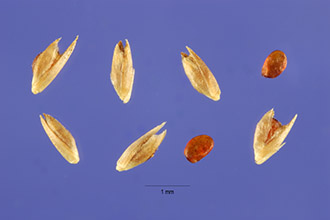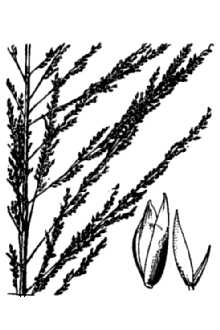Sporobolus airoides (Torr.) Torr. var. wrightii (Munro ex Scribn.) Gould
Scientific Name: Sporobolus airoides (Torr.) Torr. var. wrightii (Munro ex Scribn.) Gould

| General Information | |
|---|---|
| Usda Symbol | SPAIW |
| Group | Monocot |
| Life Cycle | Perennial |
| Growth Habits | Graminoid |
| Native Locations | SPAIW |
Plant Guide
Use soil moisture sensors to measure the soil moisture of Sporobolus airoides (Torr.) Torr. var. wrightii (Munro ex Scribn.) Gould.
Fact Sheet
Alternate Names
Sporobolus airoides (Torr.) Torr. var. wrightii (Munro ex Scribn.) Gould
Uses
Big sacaton may be used in pure stands or as part of a rangeland seeding mix for highly alkaline soils. It is useful for revegetating saline soils throughout the Southwest. It performs well as a grass hedge terrace or windstrip for erosion control. It helps stabilize watershed structures, stream banks and flood plain areas. Big sacaton is also useful for wildlife cover.
Status
Please consult the PLANTS Web site and your State Department of Natural Resources for this plant’s current status (e.g. threatened or endangered species, state noxious status, and wetland indicator values).
Description
Big sacaton (Sporobolus wrightii) is a native, warm-season grass that forms dense clumps. It is a coarse, upright bunch grass that can grow from 3 to 8 feet tall. Leaves are anywhere from 1 to 2½ inches wide and up to 1 foot long. The pale flowers of big sacaton form in stiff, upright clusters 1 to 2 feet long.
Adaptation and Distribution
Distribution
Distribution
Big sacaton grows primarily on heavier soils in lowland or wetland sites. It is tolerant of highly alkaline and saline soil, and can tolerate poorly drained soils and seasonally flooded areas. The plant is also found on open areas such as rocky slopes, plateaus, and mesas. Big sacaton is distributed throughout the Southwest. For a current distribution map, please consult the Plant Profile page for this species on the PLANTS Website.
Establishment
Seedbed preparation should begin well in advance of planting, Planting can be scheduled for early spring or where there is minimal cool-season weeds, big sacaton can also be planted in the fall, Establish a clean, weed-free seedbed by either tillage or herbicides, Prior to planting, the site should be firm and have accumulated soil moisture, © W, Use soil moisture sensors to measure the soil moisture of Sporobolus airoides (Torr.) Torr. var. wrightii (Munro ex Scribn.) Gould.,L, Wagner Smithsonian Institution @ USDA NRCS PLANTS Big sacaton seed can be drilled or broadcast, Seed should be planted at 1/8 to 1/4 inch depth, It is better to plant too shallow than too deep, A seeding rate of 1/2 to 1 pound of pure live seed per acre is recommended, Plants can also be grown in small paper containers and then transplanted for establishment of grass hedges and wind barriers, On saline soils, weed-free mulch can be used to improve establishment, Establishment is highly dependent on good rainfall or irrigation, Soil analysis should be performed prior to planting to determine salinity levels and necessary levels of nitrogen, phosphorus and potassium, Nitrogen should not be applied until the stand is established, Evaluate the stand after 60 days, If 1 plant per square foot is present than the planting has been successful,
Plant Traits
Growth Requirements
| Temperature, Minimum (°F) | -13 |
|---|---|
| Adapted to Coarse Textured Soils | Yes |
| Adapted to Fine Textured Soils | No |
| Adapted to Medium Textured Soils | Yes |
| Anaerobic Tolerance | None |
| CaCO3 Tolerance | High |
| Cold Stratification Required | No |
| Drought Tolerance | Medium |
| Fertility Requirement | Low |
| Fire Tolerance | Medium |
| Frost Free Days, Minimum | 160 |
| Hedge Tolerance | None |
| Moisture Use | Medium |
| pH, Maximum | 8.0 |
| pH, Minimum | 5.6 |
| Precipitation, Maximum | 20 |
| Precipitation, Minimum | 5 |
| Root Depth, Minimum (inches) | 20 |
| Salinity Tolerance | Low |
| Shade Tolerance | Intolerant |
Morphology/Physiology
| After Harvest Regrowth Rate | Slow |
|---|---|
| Toxicity | None |
| Shape and Orientation | Erect |
| Nitrogen Fixation | None |
| Resprout Ability | No |
| Active Growth Period | Summer |
| Bloat | None |
| C:N Ratio | High |
| Coppice Potential | No |
| Fall Conspicuous | No |
| Fire Resistant | No |
| Flower Color | Yellow |
| Flower Conspicuous | No |
| Foliage Color | Green |
| Foliage Porosity Summer | Dense |
| Foliage Texture | Coarse |
| Low Growing Grass | No |
| Lifespan | Moderate |
| Leaf Retention | No |
| Known Allelopath | No |
| Height, Mature (feet) | 5.5 |
| Growth Rate | Moderate |
| Growth Form | Bunch |
| Fruit/Seed Conspicuous | No |
| Fruit/Seed Color | Brown |
| Foliage Porosity Winter | Porous |
Reproduction
| Vegetative Spread Rate | None |
|---|---|
| Small Grain | No |
| Seedling Vigor | Medium |
| Seed Spread Rate | Moderate |
| Seed per Pound | 1965000 |
| Fruit/Seed Persistence | No |
| Propagated by Tubers | No |
| Propagated by Sprigs | No |
| Propagated by Sod | No |
| Propagated by Seed | Yes |
| Propagated by Corm | No |
| Propagated by Container | No |
| Propagated by Bulb | No |
| Propagated by Bare Root | No |
| Fruit/Seed Period End | Fall |
| Fruit/Seed Period Begin | Summer |
| Fruit/Seed Abundance | High |
| Commercial Availability | Field Collections Only |
| Bloom Period | Late Summer |
| Propagated by Cuttings | No |
Suitability/Use
| Veneer Product | No |
|---|---|
| Pulpwood Product | No |
| Protein Potential | Medium |
| Post Product | No |
| Palatable Human | No |
| Palatable Graze Animal | Medium |
| Palatable Browse Animal | Medium |
| Nursery Stock Product | No |
| Naval Store Product | No |
| Lumber Product | No |
| Fodder Product | Yes |
| Christmas Tree Product | No |
| Berry/Nut/Seed Product | No |

